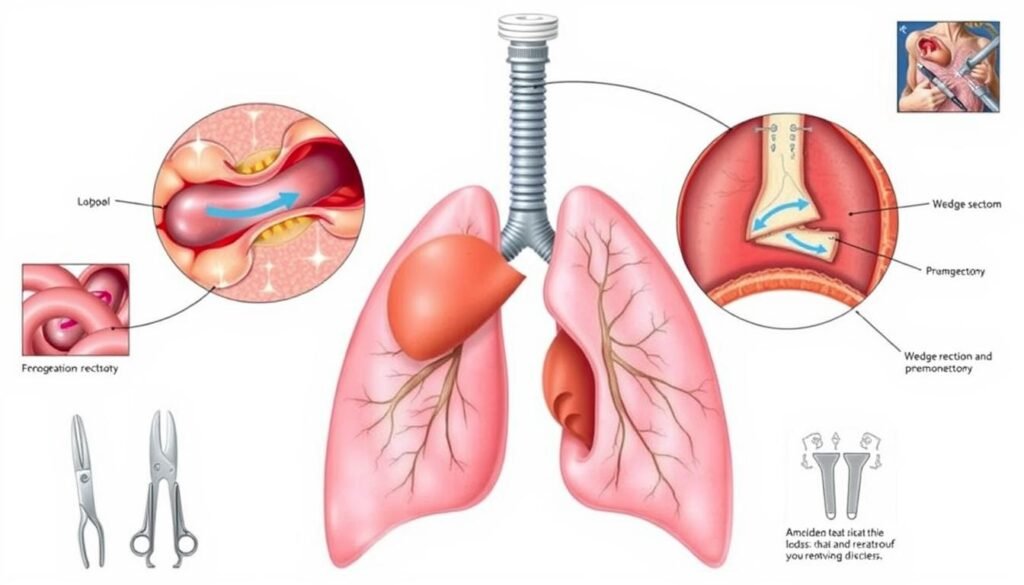Did you know lobectomy is the top choice for treating non-small cell lung cancer (NSCLC)? It successfully cures about 60-70% of early-stage patients. This high success rate shows why surgery is key in treating lung cancer. Lobectomy takes out an entire lobe of the lung. It’s been the top surgical method for more than 20 years. Studies show it’s more effective than smaller surgeries like segmentectomy and wedge resection. These are good too, especially for keeping as much lung as possible. But, lobectomy is best for lowering the chance of cancer coming back and helping patients live longer.
It’s important to know how lobectomy helps with early-stage lung cancer. By choosing surgeries that fit each patient, doctors can give them the best care. This helps improve their quality of life and chances of survival. To learn more about surgical options for lung cancer, check out this helpful link.
Key Takeaways
- Lobectomy offers effective treatment for non-small cell lung cancer.
- Options like segmentectomy may be preferable in certain cases.
- Minimally invasive techniques can enhance recovery and reduce complications.
- Personalized surgery approaches yield better patient outcomes.
- Understanding the risks involved is crucial for informed decisions.
Understanding Early-Stage Lung Cancer
Early-stage lung cancer means tumors are still inside the lungs. This is a chance for surgery to help. The main type is non-small cell lung cancer (NSCLC). It has several subtypes, affecting how patients are treated.
Now, we can find it earlier thanks to new scanning techniques. Early discovery lets more people get surgery, like lobectomy. This surgery is key for stage 1 non-small cell lung cancer.
The stage of cancer matters a lot. It affects survival rates. For example, people found to have local stage cancer have a 63% chance of surviving five years. This drops to 35% at a regional stage. Knowing the stage helps doctors plan treatment. It also gives a clearer picture of what to expect. Most stage 1 patients get less invasive surgeries, leading to easier recoveries.
Doctors might suggest extra treatments, like chemotherapy, after surgery for stage 1B cancer. This can help patients live longer. Ongoing clinical trials are testing new ways to prevent, detect, and treat lung cancer. This research helps doctors and patients choose the best treatment plans.
What Is Lobectomy and How Does It Work?
A lobectomy is a key surgery that removes a lung lobe. Each lung has lobes; three in the right and two in the left. This surgery is crucial for treating early-stage lung cancer or specific other conditions. By removing the affected lobe and some healthy tissue around it, this operation aims to rid the body of cancer. It also tries to keep as much lung function as possible.
The surgery can be done through traditional open surgery or with less invasive methods. These methods include video-assisted thoracoscopic surgery (VATS) and robotic surgery. VATS is popular because it is linked to fewer complications and deaths. This technique involves 2 to 4 small cuts, leading to a faster recovery and less pain after the operation compared to the open surgery.
Understanding lung anatomy is crucial during surgery. The right lung has three segments, while the left has two. Surgeons use advanced imaging, like 3D-CT scans, to accurately perform the surgery. This helps ensure successful removal of the diseased lung portion.
After the surgery, good care is important for a quick recovery. Patients usually stay in the hospital for 2 to 4 days. Most people go back to their normal life within a month. There are some risks, like infection or air leaks, but the overall success rate is high. This is especially true for those with early-stage lung cancer. For more details on lobectomy, check out this resource.
| Surgical Approach | Incisions | Typical Hospital Stay | Recovery Time |
|---|---|---|---|
| Open Surgery (Thoracotomy) | Large incision | Up to 7 days | 1 month |
| VATS | 2-4 small incisions | 2-4 days | 2-3 weeks |
| Robotic Surgery | 3-4 small incisions | 2-4 days | 2-3 weeks |
Benefits of Lobectomy for Early-Stage Lung Cancer
Lobectomy provides many advantages for people with early-stage lung cancer. It’s a top choice among doctors. Knowing these benefits helps patients choose their treatment wisely.
Higher Survival Rates
One big benefit of lobectomy is it leads to higher survival rates. Studies find an 80% five-year survival rate for stage I non-small-cell lung cancer through lobectomy. This is much higher than other surgical treatments. It proves lobectomy’s role as an effective cancer treatment.
Lower Risk of Cancer Recurrence
Lobectomy also cuts the risk of cancer recurrence. People who have it face a much lower chance of cancer coming back. One study showed a three times higher local recurrence rate with limited resections. This highlights lobectomy’s value in ensuring a longer remission and better prognosis.
Lobectomy Is the Preferred Option for Early-Stage Lung Cancer
Lobectomy is the best treatment for early-stage non-small cell lung cancer. Studies show its effectiveness and safety. It’s important for patients and doctors to understand its benefits.
Clinical Trial Insights
Recent studies show 73% of early-stage NSCLC patients got a lobectomy from 2006 to 2015. This operation leads to a lower 5-year cancer death rate of 23%. That’s better than sublobar resection’s 32% and SBRT’s 45%. So, lobectomy not only helps patients live longer but also proves to be the best surgical choice.
Long-Term Lung Function Preservation
Keeping lung function after surgery is vital for lung cancer survivors. Studies say keeping more lung tissue helps patients breathe better after surgery. Lobectomy removes bad tissue but keeps a lot of lung function. It is chosen over less invasive surgeries if patients can handle it.
Patients choosing lobectomy had a 70% chance of surviving 5 years. This method effectively treats cancer while saving lung function.

| Procedure | 5-Year Overall Survival Rate | 5-Year Incidence of Cancer Death |
|---|---|---|
| Lobectomy | 70% | 23% |
| Sublobar Resection | 56% | 32% |
| Stereotactic Body Radiation Therapy (SBRT) | 44% | 45% |
The Role of Surgical Intervention in Cancer Treatment
Surgery is key in treating early lung cancer. It takes out tumors, giving patients the best cure chance. This is true for non-small cell lung cancer, which is 85% of lung cancers. Doctors decide on surgery after careful tests, like scans and biopsies.
It’s important to see a thoracic surgeon who knows lung cancer well. They have a big effect on the treatment’s success. Things like lobectomy are best for early lung cancer. This surgery helps patients live longer and controls the disease better than other methods.
Knowing how surgery helps can make patients feel better about their choices. Surgery methods keep getting better, leading to great results. For more information, check out this study on lung cancer treatments.
Comparison Between Lobectomy and Other Surgical Options
Looking at early-stage lung cancer treatments, it’s key to weigh lobectomy against options like segmentectomy and wedge resection. Each method fits different needs and tumor types. This makes choosing wisely vital for the best results.
Segmentectomy vs. Lobectomy
Segmentectomy takes out a lung segment, fitting for those with weaker lungs or small tumors. Though it might seem less drastic, lobectomy often leads to better survival over time. For small tumors, studies show lobectomy has higher survival rates.
A study found lobectomy offers better overall and cancer-specific survival rates compared to segmentectomy. This is especially true for tumors that are 2 cm or smaller.
Wedge Resection vs. Lobectomy
Wedge resection removes a pie-shaped lung part, ideal for tiny tumors or saving lung tissue. However, it’s linked with more cancer coming back than lobectomy. Data confirms that for tumors ≤2 cm, lobectomy beats wedge resection in survival rates.
| Surgical Option | Recurrence Rate | 5-Year Overall Survival Rate | Ideal Candidates |
|---|---|---|---|
| Lobectomy | Lower | 78.9% to over 90% | Patients with tumors ≤2 cm |
| Segmentectomy | Moderate | Similar to lobectomy for tumors ≤1 cm | Compromised lung function, small tumors |
| Wedge Resection | Higher | Variable, generally lower than lobectomy | Small, localized tumors |

Minimally Invasive Surgical Techniques for Lobectomy
Minimally Invasive Surgery is changing how we treat lung cancer. It uses methods like Video-Assisted Thoracoscopic Surgery (VATS) and Robotic-Assisted Surgery (RATS). These techniques allow for quicker healing and less pain after surgery compared to traditional methods.
Benefits of Video-Assisted Thoracoscopic Surgery (VATS)
VATS is a big step forward in treating lung cancer. It uses high-definition cameras. This lets surgeons see the lung clearly, making surgery more precise. VATS has several key benefits:
- Smaller cuts mean less pain after surgery.
- Patients can leave the hospital sooner and get back to their lives quicker.
- There’s a lower chance of problems after surgery, and outcomes are just as good as with traditional surgery when it comes to tumor size and survival right after surgery.
Robotic-Assisted Thoracic Surgery (RATS) Advances
RATS is the next step in minimally invasive surgery. It gives surgeons better movement and control. This is especially helpful for complex surgeries. Here are some benefits of RATS:
- The surgery is very precise thanks to robotic arms that move like human hands.
- Surgeons can see and reach places in the lung that are usually hard to get to.
- The chances of having problems after surgery are the same or even less than with VATS or open surgery.
VATS and RATS are proven to work well for early-stage lung cancer. Leading cancer groups recommend these methods, mainly for stage I to IIIa lung cancer. As these surgeries get better, they will help patients even more.
Post-Surgery Recovery and Expectations
Recovery from a lobectomy can be different for each person. It depends on one’s health and the surgery details. Most patients stay in the hospital for 2 to 4 days after. During this time, doctors watch for complications such as pneumonia or air leaks. Air leaks happen when air escapes from the lung area.
Once you’re home, you’ll get detailed care instructions. It’s best to stop smoking three weeks before surgery to boost healing. Follow-up care is also key, especially if you might need chemotherapy. This usually happens six months after surgery.

- Fever
- Uncontrolled pain
- Shortness of breath
- Issues at the incision site
- Abnormal phlegm
- Bowel movement problems
These symptoms can affect how well you recover. After lung surgery, it takes weeks to go back to normal activities. Breathing exercises and mild physical activity can help. They improve lung function and wellness.
Studies show not everyone gets back to how they were before surgery, even after 90 days. Many face ongoing mental and physical issues. Surgeons should set clear expectations before surgery. Adding physical therapy or counseling can make recovery better.
Evaluating Patient Readiness for Surgery
Assessing if a patient is ready for surgery is key to success in lobectomy. It involves several important tests before the operation. These tests help find any health issues that might affect the surgery.
Importance of Preoperative Tests
Before a lobectomy, patients undergo various preoperative tests. These include:
- Pulmonary function tests to check lung capacity and function
- Cardiac evaluations to see how healthy the heart is
- Imaging studies, like CT scans, to look at tumor size and spread
This in-depth check helps doctors ensure patients are ready for surgery. It makes the surgery go smoother and helps with recovery.
Assessing Lung Function
Knowing how well a patient’s lung function is, is crucial for lung surgery. Keeping as much healthy lung as possible is important for healing and future health. Things like the amount of lung disease, any other health conditions, and if they smoke matter. These details help doctors plan how to get the patient ready for surgery and get better results.
Conclusion
Lobectomy is the top choice for treating early-stage lung cancer. It boosts survival rates and lowers the chance of the cancer coming back. This surgery is key in fighting lung cancer, which causes over 1.35 million deaths around the world each year.
New techniques, like minimally invasive surgery, are being developed. These advances offer more personalized treatment options for patients. VATS stands out by improving how early-stage lung cancer is treated. Accurate staging is crucial as it guides the treatment plan.
Working closely with skilled surgeons offers the best chance for a good outcome in lung cancer care. Ongoing research promises to make lobectomy even more effective in early-stage lung cancer treatment. This gives hope for better ways to fight lung cancer.